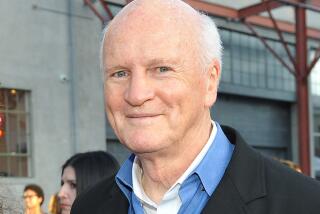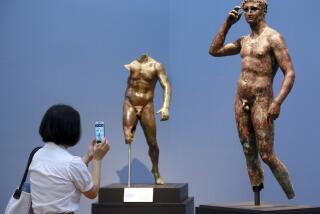Jurors Clear Gallery, Director of Obscenity : The arts: Verdict over Mapplethorpe photos will spur the assault on NEA, anti-pornography group says.
CINCINNATI — A jury acquitted an art gallery and its director Friday of obscenity charges in a trial closely watched by art institutions and anti-pornography groups across the country.
After deliberating 2 1/2 hours, the jury returned not guilty verdicts against the Contemporary Arts Center and its director, Dennis Barrie, for displaying photographs by the late Robert Mapplethorpe. Five of the 175 photos depicted homoerotic images, and two showed a child with genitals exposed.
“It’s a great day for this city,” Barrie said after the trial. “It’s a great day for America.”
When the verdict was read at about 4:30 p.m. loud whoops went up from the art center’s supporters, who leaped to their feet to hug and congratulate Barrie and other staff members.
Hamilton County Municipal Court Judge David J. Albanese ordered two men--arts center board Chairman Roger Ach and Robert Allen of Lightborne Communications, the show’s corporate sponsor--out of the courtroom for their display of emotion.
Art experts from across the country had testified in the trial, which prosecutors said was the first time a museum or art gallery has ever been tried for obscenity in this country.
“It (the verdict) sends a very important message that these museums are protected,” said Barrie.
The trial was also considered a watershed in the growing national discourse over artistic freedom of expression, which is most prominently symbolized by the fight in Congress over proposals to restrict the kinds of work that may be supported by the National Endowment for the Arts. The NEA debate is scheduled to occur in Congress next week but is subject to possible delay because of uncertainty over deficit-reduction issues.
Benjamin Bull, general counsel to the Rev. Donald Wildmon’s American Family Assn., which has fought NEA funding of exhibits such as the Mapplethorpe, said the verdict will spur on the assault on the NEA.
The legislation renewing the NEA prohibits funding of pornography, but verdicts like the one Friday mean “that NEA could fund Mapplethorpe again,” because community standards define obscenity, he said. “Rather than looking at the verdict, let’s look at the art.”
“I think this really puts the NEA issue right back in the political arena where it belongs,” Wildmon said.
But backers of the NEA took heart as well.
“I hope that (the verdict) possibly says to Congress that here’s one of the more conservative cities in the world . . . turning its back on a kind of reckless attempt to call this stuff obscene,” said John Walsh, director of the J. Paul Getty Museum in Malibu and a witness for the defense in the trial.
All eight jurors refused to speak to reporters and were escorted out of the courthouse as soon as the judge dismissed them.
The arts center and Barrie were charged April 7 with pandering obscenity and displaying children in “nudity oriented material” in connection with the retrospective exhibit, “Robert Mapplethorpe: The Perfect Moment.” The exhibit, which just ended a two-year national tour Friday in Boston, was held at the arts center for seven weeks last spring.
Defense lawyers painted the case as a fight over 1st Amendment rights and artistic freedom. Prosecutor Frank Prouty told jurors in closing statements Friday, however, that “the 1st Amendment doesn’t enter into play.”
The gist of his case simply was that the seven photographs at issue were obscene by local standards and that the defendants had violated the law by displaying them. “The pictures speak for themselves,” he said.
In a real sense, Cincinnati--and the city’s sense of itself and its values--were on trial in the tiny county courtroom, which was packed daily by members of the national press. Since the 1950s Cincinnati has produced national leaders in the movement against pornography and obscenity. Local anti-obscenity leaders today boast that Cincinnati is a clean city and that it is virtually impossible to rent an X-rated video or buy Hustler magazine here.
This is in large part the work of Simon Leis, Hamilton County’s crusading sheriff. Prouty made it clear in his arguments that this trial was an attempt to extend enforcement of obscenity laws into any venue, even those--such as museums--that were previously held sacrosanct.
“At what point in time do you say, ‘People, listen: enough’s enough as to what can or cannot be in our museums,”’ Prouty said to the jury Friday. Speaking of the arts center staff and board, he said, “Merely because they are a museum, don’t take that as a given that they’ve not violated the law.”
Marc Mezibov, the art center’s lawyer, accused law enforcement officials of exploiting and abusing the legal system.
Noting that arts center officials had given police officers a tour of the exhibit prior to opening, had decided to restrict admittance to adults and then had filed a lawsuit seeking to determine whether the photographs were obscene by local standards before the exhibit opened, Mezibov said, “I think it’s clear that the state of Ohio had no interest in determining whether the photos were obscene.”
The art center’s lawsuit was dismissed April 6, the day before the exhibit opened. The next day the museum was raided by the police.
Barrie said after the trial that the verdict had vindicated the city.
“We’re not New York. We’re not L.A. We’re not even Washington, D.C.,” he said.”We’re part of the vast middle, but that vast middle is not as dumb as people like (Sen.) Jesse Helms and Donald Wildmon think it is.”
He has contended that charges were brought against him and the museum as part of a campaign spearheaded by national right-wing groups.
Spokesmen for Citizens for Community Values, the local organization whose letter-writing campaign sparked the police and sheriff’s department investigation of the exhibit, could not be reached for comment Friday.
Barrie said the verdict, delivered by “average citizens” who don’t go to art galleries, proves that the city is more tolerant than it is portrayed to be.
Barrie’s attorney, H. Louis Sirkin, called the verdict a “serious blow” to anti-obscenity groups efforts.
“This says to the people who are trying to shut down museums and tell people what they can say and what they can see that they’d better realize that there is a protection, and it’s the best document ever written,” Sirkin said, referring to the U.S. Constitution.
Other supporters of the Cincinnati gallery were elated.
The verdict is “an extraordinary decision,” said Richard Koshalek, director of the Los Angeles Museum of Contemporary Art. “It shows there is enough sanity left in this country to bring back into equilibrium this whole issue of censorship.”
Kathleen Sulliven, a Harvard Law School professor and free speech expert, said, “I hope this will head off a slew of other prosecutorial initiatives to go after art.”
Floyd Abrams, a prominent 1st Amendment lawyer in New York, said “we’re all fortunate it came out the way it did.” The citizens of Cincinnati were “no more prepared than anywhere else to be shamed into (becoming) suppressors of freedom of expression,” he said.
Prouty, who made an impassioned appeal to the jury Friday, was closed-mouthed after the verdict. “My opinion is not an issue here,” he said. “This area, as far as the issue with regard to obscenity, is a jury’s to decide. The jury should and has in this particular case made its decision.”
“I’m elated,” said Amy Bannister, a gallery staff member, as she burst from the courtroom and into the arms of supporters who had gathered outside.
“I’m glad that this struggle is over with,” said Barrie, “but it’s not over with in the rest of the country.”
Harrison reported from Cincinnati and Parachini from Los Angeles.
More to Read
The biggest entertainment stories
Get our big stories about Hollywood, film, television, music, arts, culture and more right in your inbox as soon as they publish.
You may occasionally receive promotional content from the Los Angeles Times.










